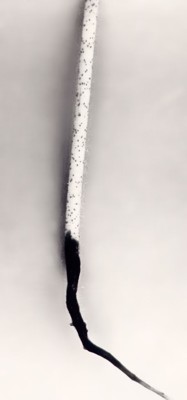Diseases
1. Thanatephorus cucumeris (A.B. Frank) Donk. 2. Thielaviopsis basicola (Berk. et Broome) Ferraris. - Root Rot of Cotton.
Systematic position.
1. Kingdom Fungi, phylum Basidiomycota, class Basidiomycetes, order Ceratobasidiales, family Ceratobasidiaceae, genus Thanatephorus.2. KingdomFungi, phylum Ascomycota, class Ascomycetes, order Microascales, genus Thielaviopsis.
Synonyms:
1. Rhizoctonia solani J.G.Kuhn; Rhizoctonia gossypii var. aegyptiaca Forsten.; Rhizoctonia aderholdii Kolosch.; Corticium areolatum Stahel.2. Trichocladium basicola (Berk. et Broome) J.W. Carmich; Torula basicola Berk. et Broome; Chalara elegans Nag Raj et W.B. Kendr. ( http://www.SpeciesFungorum.org ).
Biological group.
Saprotrophes.Morphology and biology.
Fungal pathogens Thanatephorus cucumeris and Thielaviopsis basicola are the most common causative agents of cotton root rot. The fungus T.cucumeris has mycelial (Rhizoctonia solani) and teleomorpho-basidiomycetous (Thanatephorus cucumeris) stages of development in its life cycle. Its morphological structures are brown septate mycelium, pseudosclerotia, and basidiospores. Being a polyphage, it affects many cultural and wild plants. The fungus T.cucumeris causes root rot from the beginning of seed germination to stage of 3-4 true leaves of cotton. Initially, the rot shows as dark brown necrosis on root neck or in upper part of main root. Full destruction of root tissue occurs later. Affected plants wither, having no cohesion with soil. Sources of infection by the fungus T. cucumeris are affected residues and soil. Another causative agent of cotton root rot is the fungus T. basicola having only anamorphous stage in its life cycle. Morphological structures of the pathogen are dark painted multicellular mycelium, endoconidia, and chlamydospores. The causative agent also affects other field cultures. On cotton seedlings, it shows on roots as red brown and later black necrosis. Affected plants keep turgor some time, then dry out and become black. The disease is named "Black Root Rot" because of those symptoms. The Black Root Rot can affect adult plants, thus causing their unexpected wilting. Affected plants keep withered leaves. Sources of the infection by the fungus T.basicola are affected residues and chlamydospores of the pathogen in soil.Distribution.
Root rot caused by the fungus T.cucumeris is registered everywhere in cotton growing areas of the Caucasian and Central Asian countries of the former USSR. The Black Root Rot caused by the fungus T.basicola shows in Turkmenistan and in parts of Tajikistan and Uzbekistan.Ecology.
The causative agents of the cotton root rot are soilborne fungi. The fungus T.cucumeris affects cotton varieties of Gossypium hirsutum and Gossypium barbadense. The maximal parasitic activity of the pathogen is observed at temperature 26-28°C. The fungus T. basicola affects varieties of Gossypium barbadense. It can grow at temperatures 5 to 35°C. Black Root Rot shows in field conditions intensively at soil temperature 17 to 20°C. The soil crust formed after irrigation or rain promotes intensive affection of cotton roots by the causatives agents of rot.Economic significance.
Affection of cotton seedlings by the causatives agents of root rot can reach 72% which lead to yield decrease or replanting. Control measures are crop rotation with sufficient fraction of cereals and unaffected crops, application of biological preparation of Trichoderma, cotton seed dressing, timely cultivation of soil after sprouting.Reference citations:
Gorlenko M.V. 1968. Diseases of cotton. In: Agricultural Phytopathology. Mocrow: Visshaya shkola, p. 162-177 (In Russian).Karimov H.M. 1973. Biology of the causative agent of plant black root rot Thielaviopsis basicola (Berk. et Br.) Ferraris. Abstract of PhD Thesis. Leningrad: VIZR, 18 p. (In Russian).
Menlikiev M.Ya. 1973. Investigation of Fusarium wilt of fine-fibrous cotton, development and substantiation of measures, their industrial checking in Tajik SSR. Abstract of PhD Thesis. Leningrad: VIZR, 41 p. (In Russian).
Peresypkin V.F. 1974. Diseases of cotton. In: Agricultural Phytopathology. Moscow: Kolos, p. 189-212. (In Russian).
Zdrozhevskaya S.D. 1969. Biological and toxicological basis of chemical means against seedling root rot of fine-fibrous cotton. Abstract of PhD Thesis. Leningrad: VIZR, 18 p. (In Russian).


